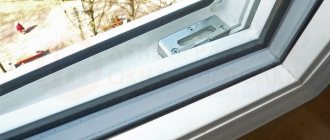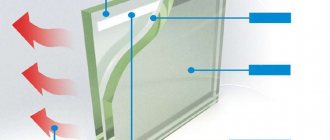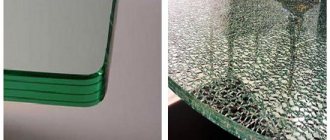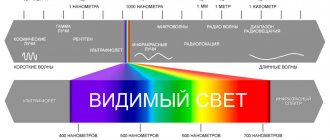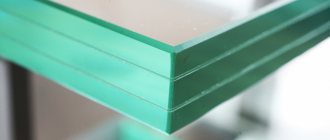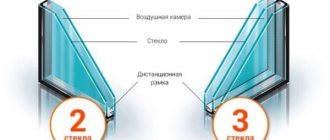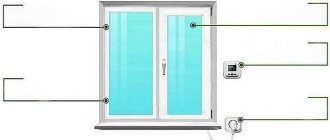Energy saving and a comfortable environment in the house largely depend on windows. Energy is lost through windows not only due to their direct contact with the cold outside air. But also by radiation in the infrared range through transparent glass.
The double-glazed window and the window as a whole must meet the requirements of energy saving standards. And the glass should be low-emission, preventing the flow of radiation energy and reflecting it back into the house.
We will consider below which glasses and double-glazed windows will be suitable for energy efficiency.
A comfortable environment in the house depends on windows
Comfort in the home largely depends on the temperature of the surfaces that surround a person. Sanitary standards set various requirements for these indicators. But you shouldn’t rely only on them; it is advisable to create a higher surface temperature of the enclosing structures inside the room.
Human skin temperature is +28 degrees. When approaching a colder (or hotter) surface, a person experiences discomfort. Significantly cooled surfaces of walls, windows, and floors create an uncomfortable environment in the house. So, according to the rules, the surface temperature of the walls should not be colder than the air in the room by more than 4 degrees.
Warm windows (energy efficient glazing) not only save money, but also create a more comfortable environment.
Heat loss through windows
The heat transfer resistance that window openings must have according to standards for most regions is in the range of 0.4 m2 •K/W - 0.7 m2 •K/W. For the Moscow region, for example, the heat transfer resistance of energy-efficient windows (selected for economic feasibility) should be at least 0.54 m2 K/W.
The heat transfer resistance of double-glazed windows is determined at their central point as the highest value, without taking into account the influence of the spacer frame (along the contour of the double-glazed window).
The heat transfer resistance of the entire window opening does not differ significantly from this characteristic of a double-glazed window. The influence of the seam, window profile, spacer frame, if the window is installed correctly and its components (including fittings) are in good condition, is not significant.
The insulation of a window opening will mainly be determined by the properties of the double-glazed window.
The specified heat transfer resistance of a double-glazed window is ensured by many design features. The type and thickness of the glass, the type of gas in the double-glazed unit, the reliability of its conservation (leakage), the type of material of the spacer frame are also affected...... But the number of cameras in a double-glazed window has a greater influence.
When choosing a double-glazed window, be interested in its heat transfer resistance. Check this data with the standard requirements for the climate of the region.
For our regions, in most cases, double-glazed windows are required.
Types of energy-saving glass
To reduce energy losses at home, it is recommended to choose glass with reduced energy emission (low-emissivity). Such glass reflects the thermal energy leaving the house in the form of infrared radiation. For this to happen, the glass must have a metallized coating. Then a significant part of the infrared radiation (more than 50%) will be reflected back into the building.
(...according to glass manufacturers, the use of sprayed energy-efficient glass in double-glazed windows in an average home saves up to 50 USD on heating per season at current energy prices...)
Experts distinguish between types of coatings that make glass energy-saving (low-emission). They talk about the possibility of hard spraying (k-coating) and soft spraying (i-coating). At the same time, i-coating is 1.5 times more energy efficient, but requires more careful handling.
You should find out about the possibility of purchasing one or another type of low-emissivity glass from the dealer who supplies double-glazed windows and installs windows.
In any case, if we are talking about a significant temperature difference across the window, it is recommended to install one outer glass with a metallized energy-reflecting coating in the double-glazed unit.
How does heating a plastic window work?
Heated double-glazed windows are a rather incomprehensible design for most Russian buyers; it is worth taking a closer look at the features of this product. In fact, this is an ordinary double-glazed window, equipped with special glass that has a heating system. This element combines two functions: heating air flows and letting natural light into the room.
Heating helps get rid of ice, condensation, and even out temperatures, eliminating temperature changes. In addition, heat often escapes through glass, and heated glass windows will help get rid of this problem. The function will not only retain the heat in the room that appears from heating devices: it can be an effective means of heating rooms, regardless of their size. The glass is heated using electricity. To do this, power supply should be provided to the window structure; You can hide it in a special box or wall it up in the wall.
The operating principle of heated glass in a window
Heating windows: insulation options
When conventional radiators do not fully cope with the functions assigned to them or a different type of heating system is used in the premises, it is recommended to install heated windows to ensure comfortable conditions. Thanks to this solution, it is possible to minimize heat leakage and maintain optimal temperature conditions in the rooms at the lowest possible cost. There are several options for heating windows on the market, so you can always choose the most suitable one.
What does it look like externally?
Heated glass does not differ much in appearance from its conventional counterpart; it is heated using a film made of metal oxides, which is not too noticeable to the eye. It must be applied to the glass during its production, so this is only possible in a factory setting, and it is no longer possible to purchase heating separately.
Thanks to the microscopic thickness, the metals do not interfere with the passage of light, and the film does not make the room dark, but this is enough to warm up the air flow.
Wire supply to the window structure
Do-it-yourself heating of window glass in an apartment
Energy saving and a comfortable environment in the house largely depend on windows. Energy is lost through windows not only due to their direct contact with the cold outside air. But also by radiation in the infrared range through transparent glass.
The double-glazed window and the window as a whole must meet the requirements of energy saving standards. And the glass should be low-emission, preventing the flow of radiation energy and reflecting it back into the house.
We will consider below which glasses and double-glazed windows will be suitable for energy efficiency.
A comfortable environment in the house depends on windows
Comfort in the home largely depends on the temperature of the surfaces that surround a person. Sanitary standards set various requirements for these indicators. But you shouldn’t rely only on them; it is advisable to create a higher surface temperature of the enclosing structures inside the room.
Human skin temperature is +28 degrees. When approaching a colder (or hotter) surface, a person experiences discomfort. Significantly cooled surfaces of walls, windows, and floors create an uncomfortable environment in the house. So, according to the rules, the surface temperature of the walls should not be colder than the air in the room by more than 4 degrees.
Warm windows (energy efficient glazing) not only save money, but also create a more comfortable environment.
Heat loss through windows
The heat transfer resistance that window openings must have according to standards for most regions is in the range of 0.4 m2 •K/W - 0.7 m2 •K/W. For the Moscow region, for example, the heat transfer resistance of energy-efficient windows (selected for economic feasibility) should be at least 0.54 m2 K/W.
The heat transfer resistance of double-glazed windows is determined at their central point as the highest value, without taking into account the influence of the spacer frame (along the contour of the double-glazed window).
The heat transfer resistance of the entire window opening does not differ significantly from this characteristic of a double-glazed window. The influence of the seam, window profile, spacer frame, if the window is installed correctly and its components (including fittings) are in good condition, is not significant.
The specified heat transfer resistance of a double-glazed window is ensured by many design features. The type and thickness of the glass, the type of gas in the double-glazed unit, the reliability of its conservation (leakage), the type of material of the spacer frame are also affected...... But the number of cameras in a double-glazed window has a greater influence.
When choosing a double-glazed window, be interested in its heat transfer resistance. Check this data with the standard requirements for the climate of the region.
For our regions, in most cases, double-glazed windows are required.
Types of energy-saving glass
To reduce energy losses at home, it is recommended to choose glass with reduced energy emission (low-emissivity). Such glass reflects the thermal energy leaving the house in the form of infrared radiation. For this to happen, the glass must have a metallized coating. Then a significant part of the infrared radiation (more than 50%) will be reflected back into the building.
(...according to glass manufacturers, the use of sprayed energy-efficient glass in double-glazed windows in an average home saves up to 50 USD on heating per season at current energy prices...)
Experts distinguish between types of coatings that make glass energy-saving (low-emission). They talk about the possibility of hard spraying (k-coating) and soft spraying (i-coating). At the same time, i-coating is 1.5 times more energy efficient, but requires more careful handling.
You should find out about the possibility of purchasing one or another type of low-emissivity glass from the dealer who supplies double-glazed windows and installs windows.
In any case, if we are talking about a significant temperature difference across the window, it is recommended to install one outer glass with a metallized energy-reflecting coating in the double-glazed unit.
The importance of correct installation
A warm window (double-chamber double-glazed window with one low-emission glass) will not perform its energy-saving functions if its installation is done incorrectly. How to install windows so that they are warm and do not fog up
When installing an energy-saving window, you need to pay attention to a few basic points.
Thus, the selected warm window with proper installation will largely provide the necessary economical energy savings in the house. It is also important to perform heat-saving finishing on the facade. How to use insulation to make a warm ventilated facade
Heated windows are new to the Russian market: they are popular not only in cold regions, but also in the southern part of the country. The system helps prevent windows from fogging up: in winter, frost will not form on them. The heating system allows you to save heat by keeping it indoors; it is built into the design of the double-glazed window at the production stage of such products.
On what principle does a double-glazed window work?
Thanks to heating, the glass remains clean for a long time, does not freeze, and ice does not form on it. The room does not become darker, since the metal mesh has cells and microscopic thickness. The load on a plastic window is less than when using a regular window, since the mesh makes it more durable. The heating system avoids the following problems:
- Regular accumulation of moisture.
- Formation of mold and fungal microorganisms.
- Contamination of plastic surfaces caused by condensation.
Heated glass units work on the same principle as an infrared heater, but differ in that the power can be set at your discretion. Such designs, powered by electricity, are energy-saving, since heated glass prevents cold air flow from entering the room, so heat loss becomes much less. This allows you to save on the operation of heating devices after installing such windows. Often such window structures are installed together with a heated floor system.
The big advantage of window systems with a heating function is selectivity: simply put, during the cold season it is not necessary to connect them to the power supply system on a permanent basis. The glass of such windows effectively reflects heat, reducing its loss, so a microclimate that is comfortable for residents is formed and maintained in the room. In summer, the design, on the contrary, helps create coolness: the glass serves to reflect heat from the outside. This allows you to significantly save on turning on the air conditioner or split system.
Wires are buried in the wall and under the windowsill
As for opening, warm windows, heated from a standard power source, can function as follows:
- Vertical opening type.
- Horizontally sliding doors.
- Solid design with fixed elements.
Flexible window heating system
Infrared elements and thermal curtains are generally effective, but have some disadvantages. For example, they require space for installation, sometimes create noise and in some cases have a negative impact on the interior. European engineers have figured out how to make a quiet and unnoticeable device that prevents windows from cooling. Its work is based on thin heating elements, which are a flexible tape that runs along the perimeter of the glass unit. Such a system consumes little energy and increases the temperature of the glass unit, eliminating cold bridges in both blind and active sashes.
In addition to being economical and compact, this system is suitable for windows that are already in use. Thanks to the minimal thickness and flexibility of the heating elements, it is possible to remove the glass unit from the frame, wrap it in tape and insert it back, and then connect it to the control unit. This device prevents condensation from forming and slows down the heat transfer process. Its integration guarantees the absence of frost on the windows even at very low temperatures.
All operations to remove the glass unit from the frame and install the heating tape must be carried out by specialized specialists.
The flexible system is best suited for openings with relatively small dimensions, since it slightly heats these products only around the perimeter. If significant heat loss through the windows is expected, then it is better to use a device that is able to heat the glass over its entire area.
Features of design and design
Depending on the client’s preferences, glass can be made with a mirrored, tinted surface, often in the form of stained glass, including using Tiffany technology. The use of such structures is relevant for large premises, for example, shopping centers, medical, preschool institutions and other facilities: most often, heated glass complements the operation of a centralized heating system, which is especially important in the harsh conditions of the Russian winter. In addition, such glazing is used in apartments and private houses, the owners of which are interested in comfort.
Externally, a heated window can be designed as usual
Heated windows can also be used in the following cases:
- The need to create a comfortable microclimate in a winter garden or greenhouse.
- Arrangement of an office building, business center.
- Construction of an exhibition hall, cultural institution or other public facility.
From the article you will learn:
The rational use of natural resources is very important today all over the world, so the introduction of heat-saving technologies is of great importance. Energy-saving devices and energy-efficient materials used in the design of houses and apartments can significantly reduce the consumption of energy sources such as gas and electricity, which saves the family budget.
Energy-saving technology can be used both in construction and renovation. You can even modernize a house that was not originally designed for such technologies. For example, a competent window design can reduce heat loss several times, and if you consider that the glazing area can reach 20–30% of the room area, and heat loss through light-transmitting structures can be up to 40% of all heat loss in a house, the benefits of using heat-saving windows are obvious .
Electrically heated windows: what will their operation cost and will it be warmer in the house?
. Wouldn't a person look for new ways to preserve precious heat in his home? One of the developments designed to reduce heat loss and maintain optimal room temperature is a warm window.
How windows are heated
The surface of the window is cold in central Russia, usually from November to March, when the air temperature outside is sub-zero and the sun shines dimly and rarely appears. Due to the low temperature of the glass, heat flows out of the room, and the air near the window is cooled. In addition, normal air circulation is disrupted, since near the window it drops to the floor. As a result, a person experiences discomfort, feeling a rather sharp change in air temperature within one room: it can be much colder near the window than, say, in the middle of the room. To eliminate this effect, water heating radiators are placed in window sill niches so that the air near the windows warms up and begins to move from the floor to the ceiling. But it's not that simple. Firstly, each radiator takes up a certain usable area of the room, and secondly, the window sill should not be too wide so as not to interfere with the air blowing through the glass. Insufficient heating of the window with warm air will lead to condensation on it, so the temperature of the radiator will have to be increased, and this will increase energy consumption.
What is electrically heated glass?
The glass can be heated not only using a radiator installed underneath it, but also through electric current. An electrically heated window allows you to maintain the optimal temperature in the room. In this case, there is no need to install heating radiators, occupying usable space. And when disconnected from the network, electrically heated double-glazed windows will work like regular low-emissivity windows.
To maintain a comfortable room temperature of +20. +30 °C, a specific power of about 0.1 kW/m² consumed by glass is sufficient
A special electrically conductive coating is applied to such glass, which acts as a heating element. It is a thin layer of solid low-emissivity material that has light transmission and energy-saving properties comparable to ordinary glass. To connect the coating to the electrical network, special current-carrying bars are applied to the glass in the edge zones. The coating reflects IR radiation from inside the room, thus reducing heat loss during the cold season, and UV radiation from the outside, thereby reducing the penetration of excess heat in hot weather and protecting interior items from damage. The glass undergoes a mandatory heat strengthening operation and/or is laminated, therefore it is safe for use in any glazing systems. The electrically conductive coating is always located inside the glass unit or triplex, which eliminates the possibility of touching the conductive layer. If the glass is cracked, the contact is interrupted and voltage is no longer supplied to the glass unit. Using integrated sensors, a special electronic system monitors the integrity and temperature of the glass.
The impetus for the development of translucent electric heating element technologies was the aviation need for safe glazing in pilot cabins that provides sufficient visibility and can effectively remove ice and condensation in all weather conditions. Today, all cabins of airplanes, trains, and chart rooms of ships are equipped with electrically heated glass in accordance with current safety standards. In the field of construction and architecture, such glass is used in two ways. The first is translucent roofs, which solve the problem of insolation and removal of snow cover in the winter. And the second is vertical glazing , which eliminates the appearance of uncomfortable air flows in the window area (the so-called “cold window breathing”) resulting from the temperature difference between the inner surface of the glass unit and the air in the room.
What is attractive about heated glass?
Heated glass can be used in a cottage in a variety of designs. It is used for glazing windows (including panoramic and attic windows), loggias and balconies, in translucent roofing and skylights, in winter gardens and swimming pools.
We list the main advantages of such glazing:
Heated glass is especially important during the off-season, when the average daily temperature has not yet fallen below the threshold level for turning on traditional heating systems, or the heating was turned off earlier and frosts struck. Usually in such cases it is necessary to install electric heaters in the rooms.
When using heated glass in a translucent roof, skylights, greenhouses and winter gardens, there is no need to clear hard-to-reach surfaces from snow and ice, the temperature in the rooms is significantly improved, and much more natural light enters them.
But that is not all. Connecting double-glazed windows to the “smart home” system will allow you to heat the windows strictly according to the schedule, coordinating it with weather changes. It is also possible to connect double-glazed windows to the cottage security system without the use of visible sensors: if any electrical contact is broken, an alarm will sound. Electrically heated windows can provide both vandal-proof and bulletproof protection. This solution is more reliable compared to traditional grilles, which in most cases simply play the role of decoration. Electric heating will allow you to save on the air conditioning process, since even when turned off, the double-glazed window will reflect IR radiation, performing a function similar to i-glass, and in the summer heat the room will heat up several times less than with a traditional double-glazed window.
In European practice, there are four main functions of electrically heated glazing: snow melting, comfort, heating, and condensation control. The most in demand in Russia is snow melting. The remaining functions, unfortunately, remain without due attention.
The key property of comfort and heating is the absence of drafts. Therefore, in the case of a large bay window or panoramic glazing, you will not have to worry about your children playing on the floor by the window in winter, and the winter garden will always be cozy and bright. An interesting feature of electrically heated windows is the ability to reduce the room temperature by 1–2 °C without any noticeable loss in comfort. As a result, we can talk about the energy efficiency of such a solution. Removing condensation in a pool using electrically heated glass is the most cost-effective solution that allows you to abandon forced glass blowing systems, and the glass will remain dry and clean.
What is the price
The electrical power supplied to the glass is calculated individually in each case. To create a comfortable indoor microclimate, the glass surface temperature must be maintained within the range from +20 to +30 °C, which is usually achieved with a power density of about 0.1 kW/m².
When using electrically heated glass as the main heating system, its surface temperature must be at +30. +45 °C, which requires a specific power of 0.3 kW/m². In the second case, the cost of electricity will be up to 450 rubles/m² per month with the glass constantly on, and this, frankly speaking, is not a very cheap way to heat a home, given that there may be several such windows even in one room.
Electrically heated glass is supplied to the domestic market by KET-GLASS LLC, the French SAINT-GOBAIN GLASS, the Finnish HATRICK OY, etc. The maximum glass dimensions are 3 × 6 m with a thickness of 4 mm. The voltage used can be either 220 V or safe 32 or 12 V. The cost of 1 m² of such electrically heated glass ranges from 9,000 rubles.
The efficiency of electrically heated double-glazed windows as heating devices is still significantly lower compared to traditional heating systems
Manufacturing and installation features
If electrically heated glass is part of a triplex, then one of the technologies of autoclave or non-autoclave lamination is used using special polymers or polymer films between two glasses. It can be ethylene vinyl acetate (EVA), polyvinyl butyral (PVB), thermoplastic polyurethane (TPU), photocurable polymer.
Installation of electrically heated glass or double-glazed windows can be done using any standard profile systems - Dorma, Schueco "Eurotitan" or similar. In profile and window systems, there are almost always gaps between the glass or double glazing and the structure, in which the wiring is laid. In tilt-and-turn sashes, flexible transitions such as GP-01, KL-486, ABLOY EA 280 are usually used for wiring installation.
Electrical installation of products with heated glass usually does not cause difficulties, provided that the work is carried out by qualified specialists. The heating can be controlled by a manual switch, using a remote device, a temperature controller, etc.
Electrically heated glass can be easily integrated into the “smart home” system, and its operation will be coordinated with other home devices
Source
The operating principle of energy-saving structures.
Over the past half century, the window industry has made huge strides forward. The first windows were a simple wooden frame with one, rarely two layers of glass - their thermal conductivity was high, they were susceptible to drying out, rotting and subsequently required additional insulation. Double glazing provided better protection from the cold; the air gap between the glasses reduced thermal conductivity by almost half, but this design was still far from ideal.
Further development led to the emergence of multi-chamber sealed packages with voids filled with an inert gas, usually argon or krypton. Such windows not only provided excellent protection from the cold, but also better resisted heat leakage from the room.
From the point of view of the laws of physics, the operation of a heat-saving window can be explained as follows. In nature, heat can spread in the following ways: conduction, convection and radiation. In the case of a window frame, the main heat losses occur through thermal conductivity and convection - cold air from the street cools the glass, and it already cools the air in the room. An emissive layer 5–7 mm thick appears on the surface of the glass. Therefore, it is necessary to eliminate or reduce the influence of air in the heat exchange between the glasses.
For this purpose, a multi-chamber double-glazed window design and filling of voids with inert gas are used. Argon has a lower molecular speed than air, so the speed of heat propagation from wall to wall will also be lower. The distance between the glasses should also not be less than 15 mm to eliminate emissive heat loss, while one of the glasses may have a special silver oxide coating to reduce thermal radiation, while sunlight passes through unhindered. It is also important to use high-quality window seals that do not lose their properties over time. Such windows are considered to be heat-saving. More often they are made of PVC (mass production), less often of wood (premium segment).
Specifications
Products are available in different sizes and are also made to order according to individual requirements. However, there are restrictions on dimensions: the minimum dimensions are 30*40 cm, the maximum – 240*480 cm. Single-chamber bags have a thickness of 17 mm, double-chamber bags – 30 mm.
Other product characteristics:
- temperature heating limits - +45...+55 degrees;
- power consumption - 50-800 W/sq. m;
- noise insulation - 31 dB;
- thermal insulation - 100 sq. m*S/W;
- UV protection degree - 95-98%.
To dry glass from condensation, a power of 100-200 W is sufficient; to heat the room, it increases to 350-500 W, which is regulated using the temperature regime.
What types of heat-saving double-glazed windows are there?
The most efficient and common are windows with two or more chambers; the distance between the panes is different for greater heat savings. The glass used must also have a number of requirements: thickness - 4 mm; a thin layer of metal oxide can be applied to one surface, preventing the penetration of ultraviolet radiation, but transmitting infrared light. In this case, heat from the room is retained by this layer and returned back.
Depending on the application technology in an energy-saving double-glazed window, two types of glass are distinguished:
- I-glass , soft coating provides the necessary level of protection and thermal conductivity, but the service life of such glasses is limited - no more than 10 years, which can be a significant drawback in certain conditions;
- K-glass , the thermal protection coefficient is one and a half times lower, but the service life, due to the harder coating, can reach several decades.
Such glasses perform well in winter, significantly reducing heat loss, but in summer, additional technology must be used to reduce heating. We are talking about reflective glasses that reflect the sun's rays and prevent objects in the room from heating up. You can use regular tinting, but such glass will get very hot and distort sunlight, although the heating will undoubtedly decrease. To achieve maximum effect, you should use multifunctional double-glazed windows that combine all these technologies.
Video description
Watch the video to learn more about the benefits of double-glazed windows with electrical heating:
Versatility of use is another advantage, because in winter the glass operates in heating mode, and in summer it prevents heat from penetrating into the room. With the help of a well-thought-out control system, the temperature can be adjusted to suit you.
If we analyze the negative reviews of heated windows, they mainly concern energy consumption, because the operation of the innovative system to a certain extent increases the monthly utility bill of the owner. According to some buyers, the price of heated glass windows is also one of the disadvantages - in comparison with conventional windows, the indicator is higher.
But in the end, you need to solve a very simple problem - what is more valuable to you - a more spacious room and comfort, or an increase in electricity bills. And if the house is well insulated, then we can confidently talk about a “slight increase”.
Source
Variety
The film differs in the type of pasting. The market offers three varieties of this product.
- Self-adhesive film. This product is easy to stick on any window. The main thing is to prevent the formation of bubbles and jammed areas when working with it. To do this, it is better to use a thick fabric and smooth out defects as necessary.
- Thermal film for window insulation. To secure it you will need thermal tape and a hair dryer. The product is attached with thermal tape, so that there is a gap between the film and the glass. Then all this is heated with a hairdryer and the product fits perfectly on the glass.
- Film without adhesive surface. This product is very easy to use. Attaches to window glass with a simple soap solution. Somewhat reminiscent of car tint. Despite its low cost, it is in no way inferior to the above-mentioned heat-saving products. It also retains heat and has a long service life.
Advice! Experts advise window coverings to be carried out exclusively in autumn or winter.
Application area
Polyester is used not only for the manufacture of thermal insulation film for windows. It is used to produce anti-glare, tinting, sun protection, energy saving and reflective materials.
High technical performance allows the product to be used in several areas at once:
- as insulation for greenhouses and greenhouses;
- insulation of balconies and loggias;
- thermal insulation of glass facades;
- finishing of a transparent roof, attic and home solarium;
- insulating walls during renovation work.
When glass is covered with film from the inside, it creates an additional barrier to heat escape. Its surface acts as an auxiliary element between the air and the glass unit. An air vacuum forms inside the window, so warm currents cannot cool quickly.
Are warm models dangerous for the user?
Some apartment and house owners fear that heated models are not safe due to the constant supply of electrical energy. Users are often wary of such models due to the imagined danger of being struck by electricity. These are simple prejudices that have no real basis - the manufacturer tried to do it in such a way as to exclude the possibility of contact with live elements. The products are well designed.
Another point is that the heating parts operate under a voltage of 12V. It is completely safe for the user who does not have heart disease and does not use the device to stimulate cardiac activity.

